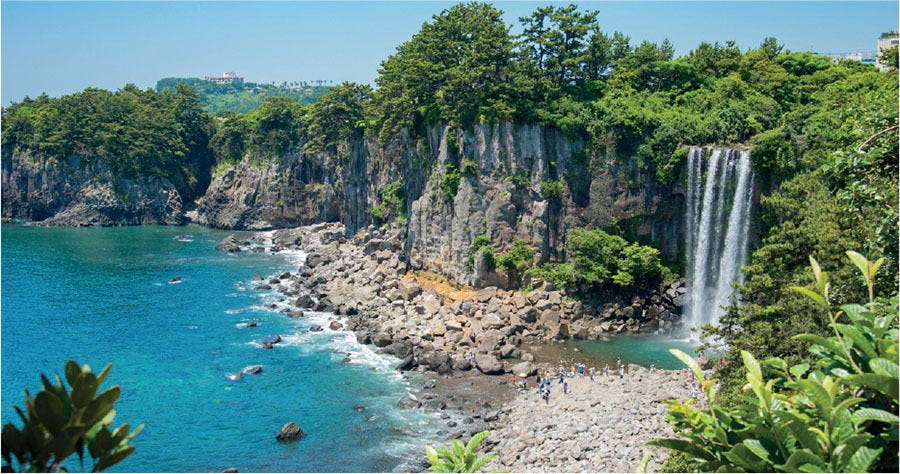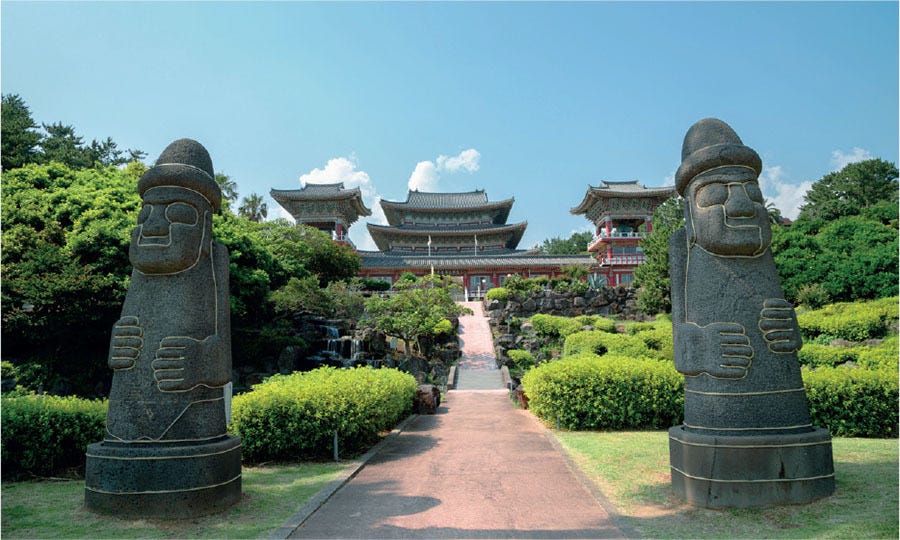The Hawaii of Asia—With a Twist of Myth and Mystery
From volcanic cliffs and waterfalls to bustling markets and Buddhist temples, Jeju Island blends natural beauty with myth and mystery.

It turns out there’s a reason that Seoul to Jeju is the busiest domestic route in the world—with over 14 million airline seats sold per year.
I had never heard of Jeju Island.
We went in blind…
“Where does this cruise go again?” My husband asked as we were boarding our grueling overnight flight westward.
“After departing Beijing, we have a day in Seoul and then on to Jeju Island before heading to Japan.” I repeated for the umpteenth time, rolling my eyes.
“What island?”
“Jeju Island!”
From our seaport, we drove along the coast as the Joseon Dynasty-style Yakchunsa Temple came into view, perched on a hillside with its towering structures. Slowly climbing in the cool, misty air gave us time to pause and absorb the sweeping views of the aqua East China Sea unfolding below.
There is a tranquility surrounding Yakchunsa that one will only find in a Buddhist temple. Even with the dozens of tourists clamoring for the best selfie around the altar with three colossal golden Buddhas.
We moved onward to Cheonjiyeon Waterfall—a gem located within Poetry Park. It was such a peaceful nature walk I marveled that we were still within Seogwipu city limits. Recent rains resulted in the falls exploding in glorious cascades into a tranquil pond.
Leaving the peacefulness of the waterfalls behind, a trip to Seogwipo Maeil Olle Market was next. Showcasing the island’s amazing seafood offerings along with produce, sweets, and unidentifiable Korean delights. I tried conch skewers cooked with a scorching blow torch before my eyes—undoubtedly a challenge to any fire code.
Insider Tip: Try to tour the market off hours. It can be insanely busy and noisy, but well worth the visit.
Ultimately, we found Jeju is not only popular for honeymooners (there are many), but also those who want to slow down, relax, and enjoy a mix of nature and adventure.
Voyaging to Jeju Island
Flights from North America to Jeju International Airport (CJU) will require at least one stopover, typically in Seoul. But there are also non-stop routes through Hong Kong, Tokyo, Taipei, Manila, Shanghai, and Beijing.
Since the journey is so long, I recommend combining the trip to Jeju with another country in the region, such as Japan or China, or time on mainland South Korea. For slow travelers, you can also cruise into Jeju (my experience); but that only allows for a day on the island.
Cruise lines including Jeju on their itinerary are Norwegian Cruise Line (NCL), Royal Caribbean Cruises, Holland America Line, MSC Cruises, Cunard, and Celebrity Cruises. Lastly, if you are on mainland Korea, you can take a ferry from Wando (2.5 hours) or 4 hours from Mokpo.
Jeju’s Greatest Hits

Jeongbang Waterfall roars down dramatic cliffs and pours into the sea (the only one that does so in Asia).
Dongmun Traditional Market or Seogwipo Maeil Olle Market are two of the largest markets on the island, offering a fascinating selection of fresh seafood, local produce, and street food.
Yakchunsa Temple is one of the largest Buddhist temples in Asia featuring three massive gold buddhas and breathtaking views of the beach and sea below.
Hyeopjae Beach, with its emerald waters and white sand contrasting the black volcanic rock, is a popular sunset beach lined with cafes.
Hyeopjaegul Lava Tube features rare stalagmites and stalactites (typically not found in lava caves). It’s located inside Hallim Park, so you can also visit the botanical gardens.
Editor’s Note: This story first appeared in the latest issue of International Living magazine. Every month, we share inspiring travel tales, expat insights, and practical guidance on living overseas. If you’d like more stories like this delivered straight to you, consider subscribing to International Living today.



Great article, enjoyable story.
What country claims Jeju Island?
Thank you.